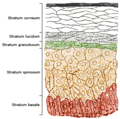Epidermis facts for kids
The epidermis is the outer layer of skin on your body. It's like a protective shield that covers you from head to toe! This layer is made of many cells that are always being replaced. In humans, the epidermis helps you feel things like touch and protects you from the outside world. The very top part of your epidermis is made stronger by a tough protein called keratin.
Contents
How the Epidermis Works
Skin's Protective Shield
The epidermis acts like a strong shield for your body. It protects you from tiny germs (microbes), strong sunlight (UV light), and harmful chemicals. It also gives your skin its strength. The very top part of the epidermis, called the stratum corneum, does most of this important work.
How the Barrier Protects You
- Physical Strength: Skin cells called keratinocytes are tightly connected. They form a strong physical wall that keeps bad things out.
- Chemical Defense: Your epidermis also has a chemical shield. This comes from special fats (lipids), acids, and tiny proteins that fight off germs.
- Immune Help: The epidermis works with your immune system to fight off sickness. It's an active part of your body's defense.
- Dry Surface: The top layer of your skin is quite dry. This makes it hard for many harmful germs to grow there.
- Acidic Surface: Your skin's surface is also a bit acidic (around pH 5.0). This low pH, along with the low water content, makes it a tough place for many germs to survive.
- Good Germs: There are also helpful, non-harmful germs living on your skin. They help protect you by using up food that bad germs might want and by releasing chemicals that stop bad germs.
Things That Can Affect the Barrier
- Stress: Feeling very stressed can weaken your skin's protective barrier. This happens because stress increases certain chemicals in your body.
- Humidity Changes: Big, sudden changes in how much moisture is in the air (humidity) can also affect your skin. This can make it easier for harmful germs to get in.
Keeping Skin Hydrated
Your skin's ability to hold water is super important for keeping it healthy. The stratum corneum is key to this. Special fats (lipids) are arranged in an organized way between your skin cells. These fats create a barrier that stops too much water from leaving your body. This helps your skin stay soft and flexible.
What Gives Skin Its Color
The main reason people have different skin colors is because of a pigment called melanin in the epidermis. Melanin is found in tiny packages called melanosomes. These melanosomes are made in special cells called melanocytes and then moved to the surrounding skin cells.
The size, number, and how these melanosomes are arranged can be different between people from various backgrounds. However, the number of melanocytes in a certain area of your body stays the same for everyone. For example, in people with white or Asian skin, the melanosomes are often grouped together. But in people with black skin, they are larger and spread out more evenly.
When you spend time in the sun (UV radiation), your skin makes more melanosomes. This is why your skin might get darker or tan when you're in the sun.
Images for kids
See also
 In Spanish: Epidermis para niños
In Spanish: Epidermis para niños







